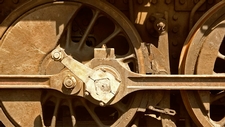Mechanical Energy

TEKS Objective
The student is expected to explore different forms of energy, including mechanical, light, sound, and heat/thermal in everyday life.
Essential Understanding
The student knows that forces cause change and that energy exists in many forms.
Science Background
Mechanics and Motion: Physics4kids (website) – Mechanical energy is the energy possessed by an object due to its motion (kinetic energy) or it position (potential energy). Learn the basics about these concepts through pictures and text.
Mechanics and Motion
by Andrew Rader, Physics4kids, www.physics4kids.com
Mechanical Energy: The Physics Classroom (website) - Nice overview, including terminology, of mechanical energy. Includes links to student activities and additional background content.
The Physics Classroom
Mechanical Energy, www.physicsclassroom.com
Signature Lesson
Educator Info, Build a Roller Coaster: Museum of Science and Industry (website) - Students investigate mechanical energy (kinetic) by constructing a roller coaster for a marble.
Educator Info, Build a Roller Coaster
Museum of Science and Industry, www.msichicago.org
- Supporting Lessons
- Extensions
- Assessment Ideas
- Literature Connections
- Related
TEKS - Additional Resources
Supporting Lessons
Making Objects Move: Science NetLinks (website) - Students study the motion of objects and create, test and revise a structure able to move an object from one place to another.
Making Objects Move
Science NetLinks, www.sciencenetlink.com
Elaboration Lessons and Extensions
Potential and Kinetic Energy, Spool Racer: PBS Kids (PDF) - Students construct racers from spools.
Potential and Kinetic Energy, Spool Racer
PBS Kids, www.pbskids.org
Marvelous Machines: Pieces of Science (website) - A collection of easy activities using simple machines.
Marvelous Machines
Pieces of Science, The Franklin Institute, www.fi.edu/pieces
Assessment Ideas
Imagine an object rolling down a ramp.
- If you wanted the object to roll more slowly, what would you do? Draw and label the ramp that you would build.
- If you wanted the object to roll more quickly, what would you do? Draw and label the ramp that you would build.
Literature Connections
Energy and Power. Harlow, R. (ISBN-13: 978-0753455029)
A Crash Course in Forces and Motion with Max Axiom, Super Scientist. Sohn, Emily (ISBN-13: 978-0736868372)
Isaac Newton and the Laws of Motion. Gianopoulos, A. (ISBN-13: 978-0736868471)
Additional Resources
Energy Education & Workforce Development: US Department of Energy (website) - Searchable website with lessons, projects and informational resources about different types of energy.
Energy Education & Workforce Development
US Department of Energy, www1.eere.energy.gov
Energy: Science Online (website) - Interactive site, organized by grade, with lesson plans, worksheets, activities, and resources for teaching the science of energy.
TEKS Navigation
Grade 3
Need Assistance?
If you need help or have a question please use the links below to help resolve your problem.

Comments